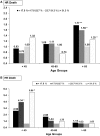Transferrin saturation ratio and risk of total and cardiovascular mortality in the general population
- PMID: 24599805
- PMCID: PMC4108849
- DOI: 10.1093/qjmed/hcu045
Transferrin saturation ratio and risk of total and cardiovascular mortality in the general population
Abstract
Background: The transferrin saturation (TSAT) ratio is a commonly used indicator of iron deficiency and iron overload in clinical practice but precise relationships with total and cardiovascular mortality are unclear.
Purpose: To better understand this relationship, we explored the association of TSAT ratio (serum iron/total iron binding capacity) with mortality in the general population.
Methods: The relationships of TSAT ratio with total and cardiovascular mortality were explored in 15 823 subjects age 20 and older from the Third National Health and Nutrition Examination Survey (1988-94). All subjects had vital status assessed through to 2006.
Results: During follow-up, 9.7% died of which 4.4% were from cardiovascular disease. In unadjusted analysis, increasing TSAT ratio was inversely associated with mortality. With adjustment for baseline demographic and clinical characteristics, the TSAT-mortality relationship followed a j-shaped pattern. Compared with the referent group [ratio 23.7-31.3%: hazard ratio (HR) =1.00], subjects in the lowest two quartiles, <17.5 % and 17.5-23.7 %, experienced significantly higher mortality risks of 1.45 (1.19-1.77) and 1.27 (1.06-1.53), respectively, whereas subjects in the highest quartile, >31.3 %, experienced significantly higher mortality risks of 1.23 (1.01-1.49). The pattern of association was more pronounced for cardiovascular mortality with significantly higher mortality risks for the lowest two quartiles [HR = 2.09 (1.43-3.05) and 1.90 (1.33-2.72), respectively] and highest quartile HR = 1.59 (1.05-2.40).
Conclusions: Both low and high TSAT ratios are significantly and independently associated with increased total and cardiovascular mortality. The optimal TSAT ratio associated with the greatest survival is between 24% and 40%.
© The Author 2014. Published by Oxford University Press on behalf of the Association of Physicians.
Figures


References
-
- Andrews NC. Disorders of iron metabolism. Chap 46. In: Handin RI, Lux SE, Stossel TP, editors. Blood: Principles & Practice of Hematology. 2nd edn. Philadelphia USA: Lippincott Williams & Wilkins; 2003. pp. 1399–433.
-
- Cook JD. Clinical evaluation of iron deficiency. Semin Hematol. 1982;19:6–18. - PubMed
-
- KDOQI; National Kidney Foundation. II. Clinical practice guidelines and clinical practice recommendations for anemia in chronic kidney disease in adults. Am J Kidney Dis. 2006;47(5 Suppl 3):S16–85. - PubMed
-
- Edwards CQ, Kushner JP. Screening for hemochromatosis. N Engl J Med. 1993;328:1616. - PubMed
-
- Pippard MJ. Detection of iron overload. Lancet. 1997;349:73. - PubMed
Publication types
MeSH terms
Substances
LinkOut - more resources
Full Text Sources
Other Literature Sources

